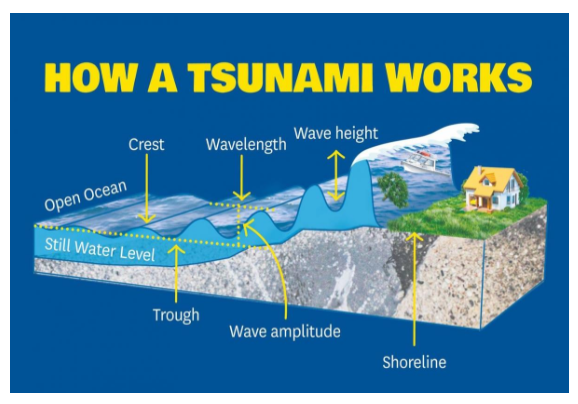Important-geophysical-phenomenon / Important Geophysical Phenomenon / Tsunami
The term "tsunami" is a Japanese term that translates to "harbour wave." This name reflects the nature of these waves, often characterised by their immense size and potential to cause significant destruction along coastlines when they make landfall.
- Tsunamis are indeed long-wavelength waves often created by underwater disturbances, such as seismic activities, volcanic eruptions, landslides, or even meteorite impacts.
- Their immense energy and lengthy wavelengths allow them to travel across entire ocean basins, making them incredibly destructive when they reach coastlines.
- Submarine landslides, volcanic eruptions, and seismic activities are some of the most common causes, but they can also be generated by extraterrestrial objects colliding with Earth, although such occurrences are extremely rare.

CAUSES OF TSUNAMI
- Tsunamis are generally triggered by the vertical movement of the seafloor, and earthquakes are the primary cause.
- The displacement of the seafloor during an earthquake—particularly along subduction zones and ocean trenches—generates these destructive waves.
- Other causes, such as underwater explosions (like nuclear testing), volcanic eruptions in coastal areas, landslides caused by earthquakes or volcanic activity, and even meteorite impacts, can also potentially create tsunamis.
- The effects of an ancient meteorite impact roughly 5 million years ago seem to have led to tsunamis, leaving deposits along the Gulf Coast of Mexico and the United States.
Mitigating the impact of tsunamis involves several steps that can save lives and minimise damage:
- Early Warning Systems: Efficient early warning systems are critical in minimising the impact of tsunamis. These systems include monitoring devices such as buoys, seismographs, and tidal gauges to detect abnormal sea level changes, seismic activities, and warn authorities and the public in vulnerable areas.
- Community Preparedness: Community-based education and preparedness programs are crucial. Educating the local population about the signs of a potential tsunami and how to react can save lives. Training people to recognize natural warning signs, such as strong, long-lasting earthquakes, and seeking higher ground immediately, can significantly reduce casualties.
- Evacuation Plans: Establishing clear evacuation routes and plans is essential. People should know where to go and what to do in the event of a tsunami warning. Evacuation drills and practice can make a significant difference in how people respond in an emergency.
- Infrastructure and Urban Planning: Constructing buildings and infrastructure that can better withstand tsunami waves is critical. Designing structures that can resist the force of waves, such as elevated buildings and barriers, and incorporating this into urban planning can reduce damage.
- Governmental and International Cooperation: Tsunamis can affect large regions and require coordinated efforts between governments, organisations, and neighbouring nations for timely and effective warnings and responses.
By taking proactive steps and investing in early warning systems, preparedness, infrastructure, and cooperation, the impact of tsunamis can be significantly reduced.

